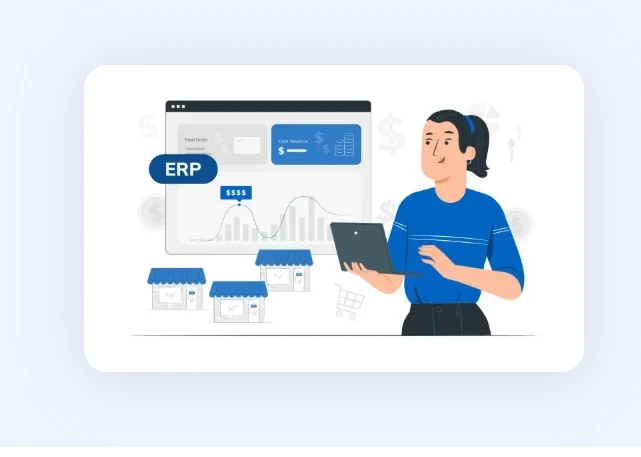The retail industry has always been one of the most dynamic sectors of the economy. From small family-owned shops to global retail chains, businesses constantly seek ways to stay competitive, cut costs, and maximize profits. In today’s fast-paced, digital-first world, achieving these goals requires more than just traditional management practices—it requires robust technological solutions. One such powerful tool is ERP software for retail business.
ERP (Enterprise Resource Planning) systems have revolutionized the way retailers operate by streamlining processes, optimizing resource allocation, and providing real-time insights into performance. When implemented correctly, ERP for retail stores not only reduces operational costs but also paves the way for higher profitability and growth.
This article explores how ERP software reduces costs and increases profits for retailers, the key benefits, features, and best practices for successful implementation.
Understanding ERP Software for Retail
ERP software is an integrated platform that connects all core functions of a retail business—sales, inventory, purchasing, finance, customer service, human resources, and supply chain management—into a centralized system.
For retailers, this means having a single source of truth that provides real-time visibility across stores, warehouses, suppliers, and customers. Unlike standalone solutions, ERP software for retail eliminates silos, reduces inefficiencies, and ensures seamless collaboration between departments.
How ERP Reduces Costs for Retail Businesses
One of the primary goals of any ERP system is to optimize operations and minimize unnecessary expenses. Here’s how ERP achieves cost reduction in retail:
1. Inventory Optimization
Poor inventory management is one of the biggest cost drivers in retail. Overstocking ties up capital, while understocking leads to lost sales. ERP solutions use real-time data, demand forecasting, and automated stock replenishment to ensure optimal stock levels. This prevents both overstocking and stockouts, reducing waste and lost revenue.
2. Improved Supply Chain Efficiency
An efficient supply chain reduces costs at every step—from procurement to delivery. ERP software integrates suppliers, logistics partners, and warehouses, ensuring better coordination, faster delivery, and reduced logistics costs. Retailers can negotiate better deals with suppliers by having data-backed insights into demand and purchasing trends.
3. Automation of Manual Processes
Manual processes like order entry, invoicing, and reporting consume time and increase the risk of human error. ERP automates these processes, reducing administrative costs while improving accuracy. This allows retail staff to focus on customer service and strategic activities rather than paperwork.
4. Reduced IT and Software Costs
Instead of relying on multiple disconnected software tools for accounting, inventory, POS, and HR, retailers can consolidate everything into one ERP system. This reduces licensing costs, IT maintenance expenses, and integration challenges.
5. Minimized Shrinkage and Theft
Retail shrinkage caused by theft, fraud, and mismanagement significantly impacts profitability. ERP systems track inventory across all stores and warehouses in real time, flagging discrepancies and unusual activities. This helps reduce losses and improve accountability.
How ERP Increases Profits for Retail Businesses
Beyond cost savings, ERP systems actively contribute to increasing profitability. Let’s explore how:
1. Better Customer Experience
Happy customers are loyal customers. ERP provides a 360-degree view of customers, including their purchase history, preferences, and interactions. This enables retailers to personalize promotions, enhance service quality, and build long-term relationships that drive repeat business.
2. Data-Driven Decision Making
ERP software provides real-time dashboards and analytics that empower managers to make informed decisions. From adjusting pricing strategies to identifying top-selling products, these insights directly boost revenue. Retailers can also track store performance and quickly adapt to market changes.
3. Improved Sales and Marketing Campaigns
By analyzing customer data, ERP helps retailers create targeted marketing campaigns that maximize conversion rates. For example, personalized discounts based on past purchases or location-specific offers can increase sales without unnecessary marketing spend.
4. Multi-Store Management
For retailers operating across multiple locations, managing consistency can be challenging. ERP centralizes operations, ensuring pricing, promotions, and stock levels are aligned across stores. This uniformity strengthens brand presence and prevents revenue leakage.
5. Enhanced Employee Productivity
With automated processes and simplified workflows, employees can handle more transactions in less time. Improved efficiency leads to faster customer service, increased sales throughput, and overall higher profitability.
Key Features of ERP Software for Retail Business
When selecting ERP software for retail, it’s important to choose a system with features tailored to the unique challenges of the retail industry. Here are some must-have features:
- Point of Sale (POS) Integration – Seamless synchronization between in-store and online sales channels.
- Inventory Management – Real-time tracking, demand forecasting, and automated replenishment.
- Customer Relationship Management (CRM) – Tools for personalized marketing and loyalty programs.
- Financial Management – Automated invoicing, accounting, and tax compliance.
- Supply Chain Management – End-to-end visibility into procurement and logistics.
- E-commerce Integration – Unified operations across physical stores and online platforms.
- Business Intelligence (BI) and Analytics – Real-time reporting and performance monitoring.
- Multi-Store and Multi-Currency Support – Essential for expanding retail businesses.
Best Practices for Implementing ERP in Retail
While ERP promises significant benefits, its success depends on proper implementation. Retailers should follow these best practices:
1. Define Clear Objectives
Before implementation, retailers must identify their primary goals—whether it’s reducing costs, improving inventory accuracy, or enhancing customer experience. Clear objectives guide system configuration and adoption.
2. Choose the Right Vendor
Not all ERP solutions are designed for retail. Retailers should evaluate vendors with proven experience in ERP for retail stores and assess scalability, integrations, and customer support.
3. Ensure Employee Training
ERP systems can be complex, and successful adoption requires staff to fully understand how to use the software. Comprehensive training programs reduce resistance and improve utilization.
4. Start Small, Scale Gradually
Large-scale ERP rollouts can be overwhelming. Retailers should start with core modules like inventory and finance, then expand to CRM and supply chain management as the business adapts.
5. Monitor and Optimize Continuously
Implementation is not the end of the journey. Retailers should monitor KPIs such as inventory turnover, order accuracy, and customer satisfaction to ensure the ERP system is delivering value. Regular updates and improvements maximize ROI.
Real-World Example: ERP in Action for Retail
Consider a mid-sized clothing retailer with 20 stores across different cities. Before implementing ERP, the company struggled with:
- Overstocked warehouses leading to high carrying costs.
- Frequent stockouts of popular items.
- Poor visibility into sales trends across stores.
- Inefficient manual processes that slowed down operations.
After deploying ERP software for retail business, the company achieved:
- 20% reduction in inventory costs through better forecasting.
- 15% increase in sales by ensuring popular items were always in stock.
- Faster decision-making with real-time dashboards.
- Improved customer satisfaction through personalized offers.
This case illustrates how ERP directly reduces costs and enhances profits while improving the overall shopping experience.
The Future of ERP in Retail
The role of ERP in retail is evolving with advancements in technology. Cloud-based ERP systems are becoming increasingly popular due to lower upfront costs, scalability, and remote accessibility. Artificial intelligence (AI) and machine learning (ML) are also being integrated into ERP platforms, enabling predictive analytics, smart demand forecasting, and automated decision-making.
Additionally, ERP solutions are increasingly integrated with e-commerce platforms, enabling unified retail operations across physical and digital channels. With the rise of omnichannel retailing, ERP is no longer a luxury but a necessity for growth-oriented businesses.
Conclusion
In the highly competitive retail landscape, cutting costs and maximizing profits are essential for survival and success. ERP software for retail business plays a crucial role in achieving these goals by streamlining operations, optimizing resources, and providing actionable insights.
From inventory optimization to improved customer experiences, the benefits of ERP are undeniable. Retailers who adopt ERP for retail stores can expect not only reduced operational costs but also sustainable profitability and long-term growth.



